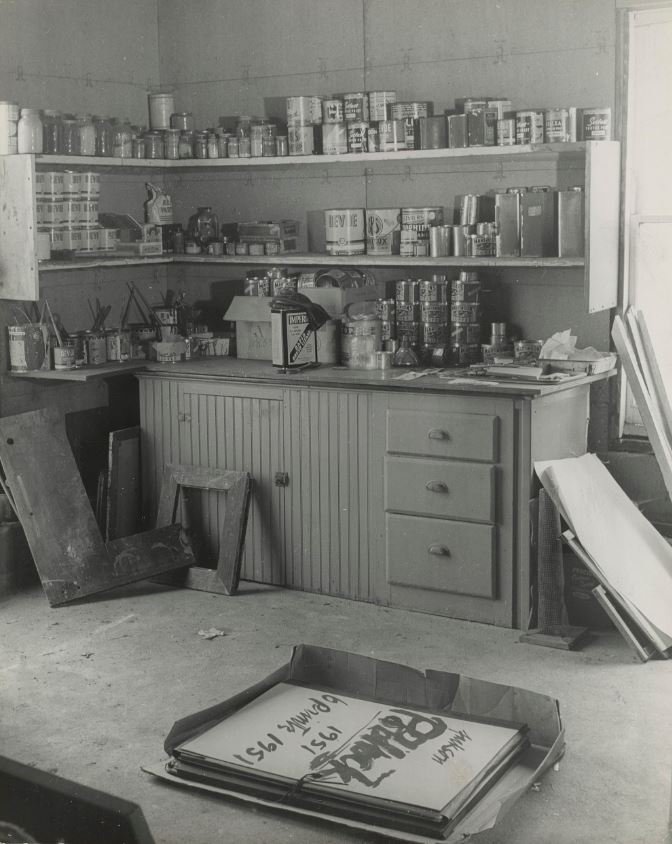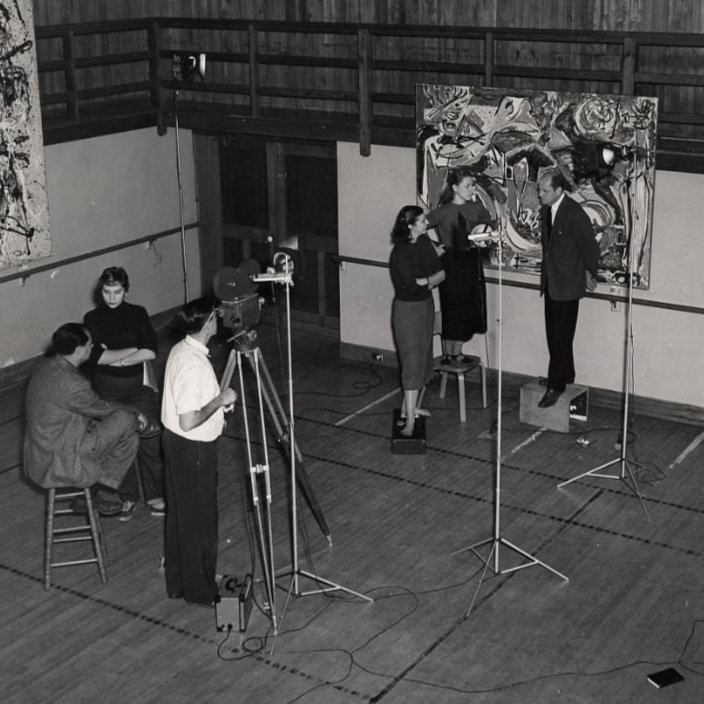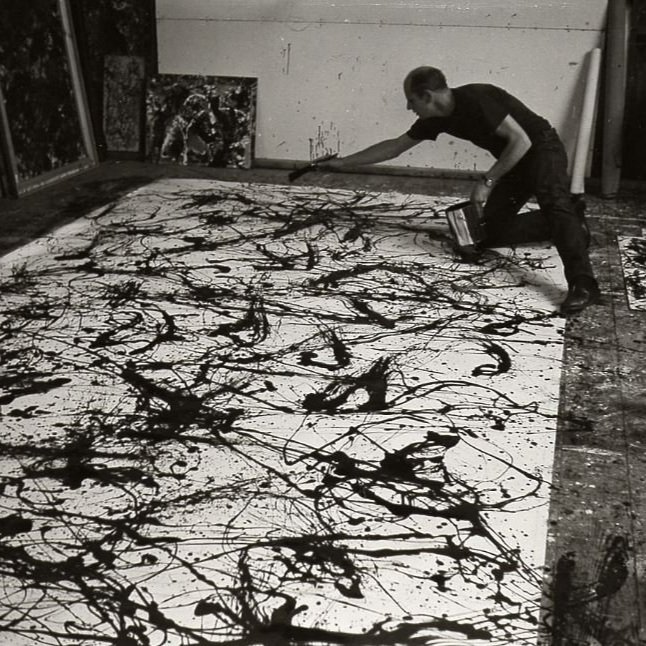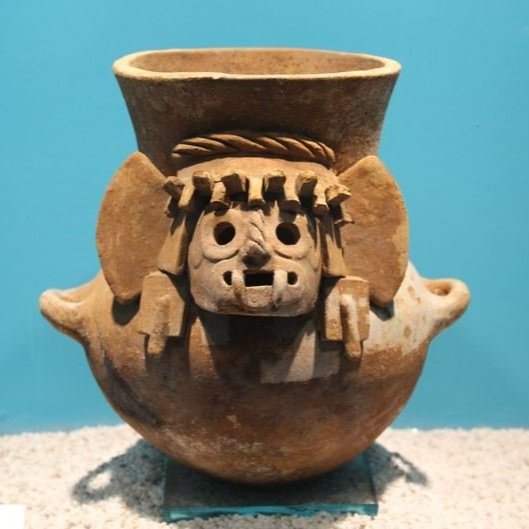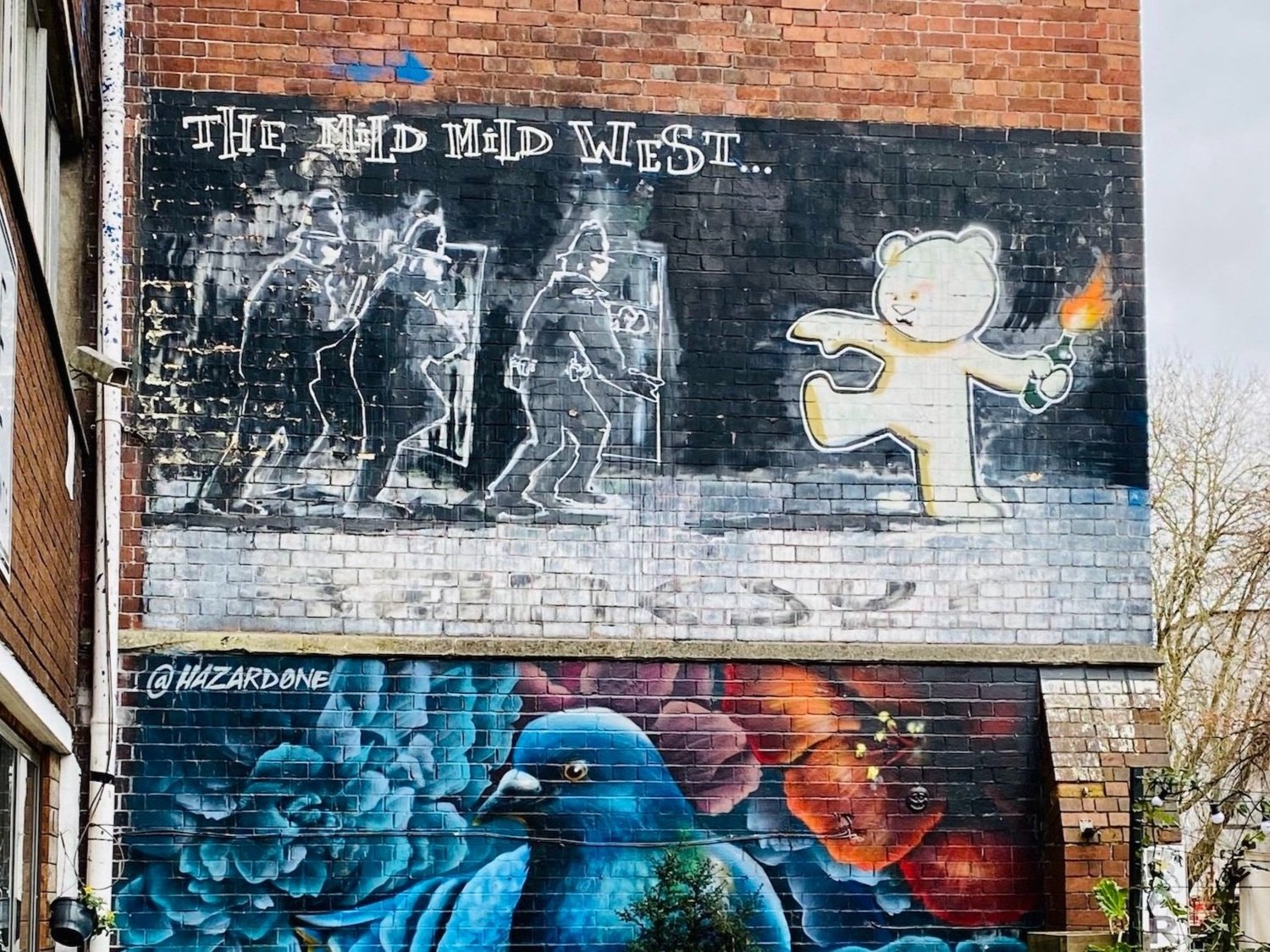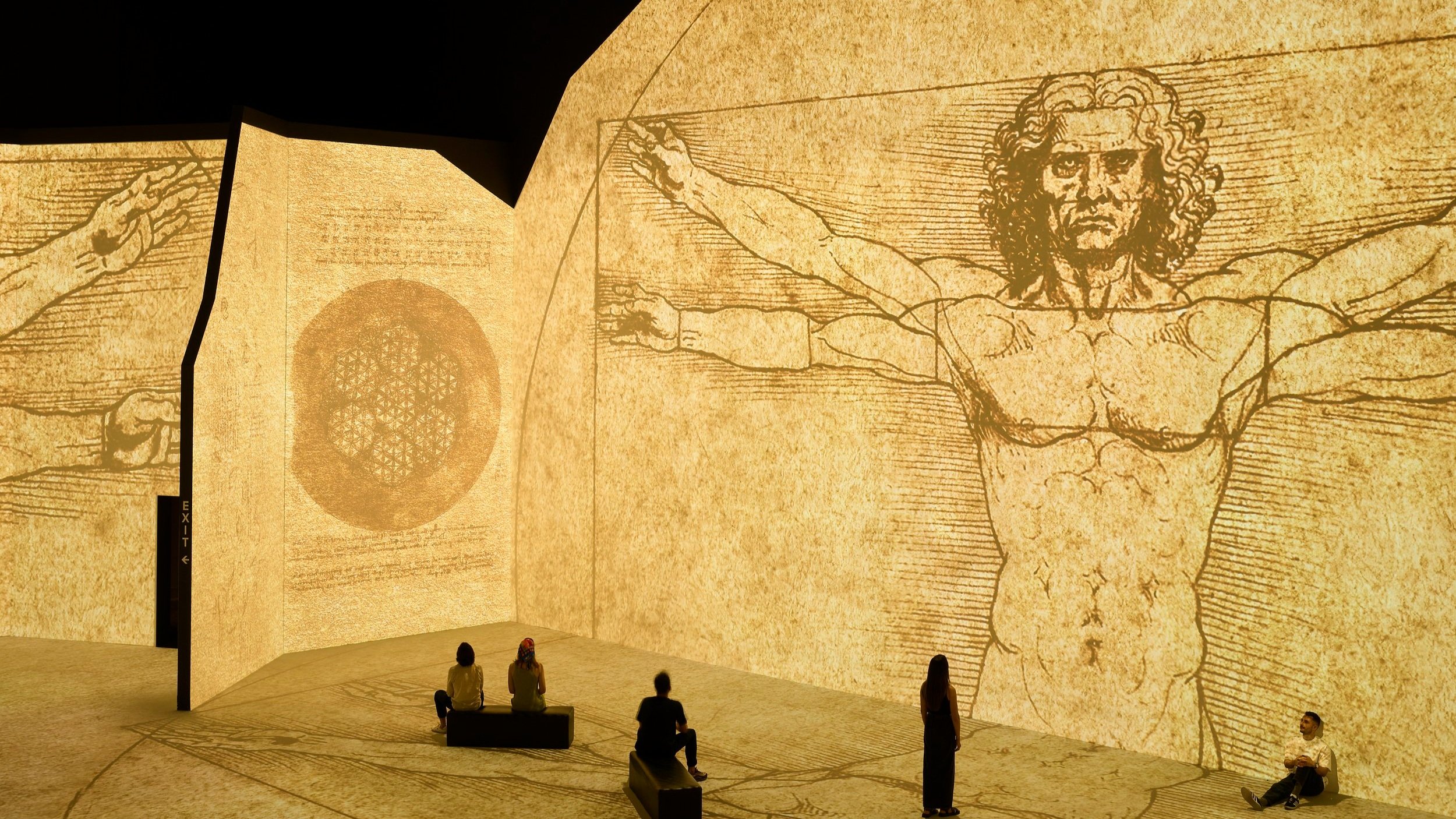Why is Jackson Pollock considered a great artist?
Jackson Pollock at the Art of This Century gallery, 1947. Archives of American Art, Smithsonian Institution
In this article, I explore the life and works of one of the most famous artists of the 20th century, Jackson Pollock to understand why he was considered a great artist.
Pollock was a pioneer of the Abstract Expressionist movement, which aimed to convey emotions and ideas through non-representational forms. His revolutionary “drip painting” technique pushed the boundaries of traditional painting methods and expanded the possibilities of artistic expression.
His paintings are often seen as windows into his psyche, reflecting his emotional and psychological state. Pollock’s art challenged conventional notions of what art should be, inspiring countless artists to experiment with new techniques and forms of expression.
Read on to find out more on Jackson Pollock and the legacy of his artworks.
1. The Life and Art of Jackson Pollock
Jackson Pollock, circa 1950. Archives of American Art, Smithsonian Institution
Artistic brilliance often finds its roots in intriguing life stories, and Jackson Pollock’s journey is no exception. This section delves into Pollock's captivating life and his artistic evolution that ultimately led to the creation of his revolutionary drip technique, forever altering the course of modern art.
Early Years and Artistic Journey
Jackson Pollock’s artistic journey began in the vast landscapes of the American West.
Raised in a modest household in Cody, Wyoming, his exposure to the expansive wilderness and Native American art laid the foundation for his unique perspective.
Pollock’s early years were marked by an innate curiosity, a quality that would propel his creative exploration. At a tender age, Pollock displayed an affinity for sketching and drawing. His artistic talent was recognised by his family and teachers, who nurtured his passion.
This encouragement set the stage for Pollock’s formal training, where he developed technical skills that would later merge seamlessly with his avant-garde approach.
Evolution of Pollock’s Style
Pollock’s artistic style underwent a gradual evolution, reflecting his innate ability to fuse diverse influences. From his initial fascination with regional landscapes to his engagement with Mexican muralists’ works, Pollock’s early influences were diverse and eclectic.
As he transitioned from regionalism to abstraction, Pollock’s art became a canvas for his inner emotions and subconscious impulses. This transformative journey can be traced through his works, from figurative compositions to increasingly abstract forms that began to hint at the radical departure he was about to make.
The pinnacle of Pollock’s artistic transformation arrived with the revolutionary drip technique. This marked a departure from traditional brushwork, as Pollock laid his canvases on the floor and applied paint in a controlled yet spontaneous manner.
2. Exploring Jackson Pollock's Painting Technique
The Complexity of Drip Painting
Jackson Pollock painting in his studio, 1947. Archives of American Art, Smithsonian Institution.
Pollock’s drip technique is an intricate dance between spontaneity and control.
His approach challenged traditional notions of brushwork and composition, embracing an innovative process that gave rise to complex visual narratives. By layering drips, spatters, and splashes of paint onto the canvas, Pollock infused his works with a dynamic energy that captivated the viewer’s imagination.
The chaos of dripping and splattering paint onto the canvas was not mere randomness. Instead, Pollock’s gestures were imbued with intention, reflecting his emotional state and artistic vision. The resulting abstraction allowed viewers to explore the artwork’s depths and engage with their own interpretations.
Understanding Pollock’s Process and Execution
Jackson Pollock’s process was a blend of calculated intent and spontaneous action. He would lay a canvas on the floor or wall, enabling him to approach the artwork from all angles. With cans of paint containing various hues, he would begin the rhythmic dance of pouring, flicking, and drizzling paint across the surface. The immediacy of the technique allowed him to capture the essence of the moment, freezing time within the layers of paint.
His fluid motions became an extension of his thoughts and emotions, creating a symbiotic relationship between creator and creation. This connection, combined with his innovative approach, led to artwork that defied convention.
Materials and Tools in Pollock’s Studio
Pollock’s studio was a sanctuary of artistic exploration, filled with an array of materials that fueled his creative process. From commercial oil-based paints to enamel and household paints, Pollock utilized a variety of mediums to achieve different textures and effects. His use of unconventional materials showcased his desire to experiment and push the boundaries of traditional painting.
The tools Pollock employed were equally diverse, ranging from brushes and sticks to turkey basters and his own hands. Each implement added a distinct texture and dimension to his works, contributing to the rich visual tapestry that emerged from his artistic endeavours.
3. Analysing Jackson Pollock’s Key Artworks
“Autumn Rhythm”: A Dance of Colour and Chaos
Autumn Rhythm at The Metropolitan Museum, New York
“Autumn Rhythm” stands as a testament to Pollock’s ability to translate raw emotion into visual form. This expansive canvas draws the viewer into a realm of vibrant hues and energetic movement. Layers of dripped and poured paint create a symphony of colour, evoking the essence of nature’s transformation during the autumn season. The chaos within the composition mirrors the unpredictability of life, inviting us to explore the interplay between control and spontaneity.
The artwork’s sheer scale demands a physical response from the viewer, encouraging them to step closer and immerse themselves in the intricacies of the painting. “Autumn Rhythm” is a manifestation of Pollock’s unique approach to abstraction, transcending mere representation to convey a profound emotional experience.
“Number 1A, 1948”: Capturing the Essence of Pollock
Number 1A, 1948 at Museum of Modern Art, New York
"Number 1A, 1948" serves as a quintessential representation of Pollock’s innovative technique and his deep connection to the canvas. Layers of dripped and splattered paint intertwine to form a complex web of lines, shapes, and textures. The absence of traditional forms and figures challenges viewers to engage with the artwork on an intuitive level, encouraging them to seek meaning within the chaos.
The canvas becomes a site of exploration, a visual labyrinth where the viewer can lose themselves in the ebb and flow of paint. “Number 1A, 1948” captures the essence of Pollock’s creative process, offering a glimpse into his world of boundless experimentation and unbridled expression.
“Blue Poles”
“Blue Poles” is a testament to Pollock’s artistic prowess, but its reception was controversial. The towering canvas features a series of vertical blue lines interspersed with vibrant drips of colour. While the artwork is a prime example of Pollock’s drip technique, it was initially marred by debate over its meaning, value, and the artist’s intent.
The controversy surrounding “Blue Poles” highlights the divisive nature of abstract art and the challenges of interpreting Pollock’s work. However, it also underscores the enduring power of his creations to provoke thought and spark dialogue.
4. Jackson Pollock’s Cultural and Historical Context
Post-World War II America: A Crucible for Artistic Innovation
The aftermath of World War II was a time of upheaval, reconstruction, and shifting perspectives. The war’s devastation led to a collective search for new meaning, and the arts became a method for expressing the complexities of the human experience. It was against this backdrop of renewal and reinvention that Jackson Pollock’s innovative approach to art developed.
As the world grappled with the horrors of war, artists like Pollock sought to channel their emotions and reflections through their creations. The trauma of conflict, coupled with the desire for renewal, set the stage for a new era of artistic exploration that challenged traditional norms.
Pollock’s Art in the Context of Cold War Tensions
The Cold War era marked not only political tension but also a cultural battleground where ideas and ideologies clashed.
In the United States, the dominance of Abstract Expressionism, a movement Pollock played a pivotal role in shaping, became synonymous with American artistic innovation. Pollock’s art, with its emphasis on individualism, freedom of expression, and emotive abstraction, embodied the spirit of a nation seeking to define itself in contrast to its Cold War adversaries.
Pollock’s works, characterised by their raw emotion and lack of adherence to conventions, mirrored the nation’s struggle to reconcile its identity in the face of global uncertainty. His art was a testament to the power of individual expression as a counterpoint to rigid ideological frameworks.
The Beat Generation and Pollock’s Iconic Status
The Beat Generation, a group of writers and artists known for their rejection of mainstream values, found common ground with Pollock’s artistic ethos. The movement’s emphasis on spontaneity, rejection of conformity, and exploration of the human psyche resonated with Pollock’s approach to art.
His work became a symbol of rebellion and freedom, inspiring a new wave of artistic experimentation that transcended traditional boundaries.
Jackson Pollock’s art was intricately interwoven with the cultural and historical context of post-World War II America. As we reflect on the dynamic landscape that shaped his emergence, it becomes evident that his art was not only a reflection of his personal expression but also a mirror to the evolving identity of a nation in transition.
5. Jackson Pollock: The Critical Reception and Controversies
Lloyd Studios. Jackson Pollock at the Bennington show, 1952. Archives of American Art, Smithsonian Institution.
Jackson Pollock’s art has sparked a plethora of interpretations and controversies that continue to captivate scholars, art enthusiasts, and critics alike.
Initial Reactions and the Art Establishment’s Response
When Jackson Pollock’s radical and unconventional approach burst onto the art scene, the reactions were a mixture of awe, skepticism, and intrigue.
Traditionalists grappled with the departure from established norms, while avant-garde proponents celebrated the innovation. The art establishment, however, took time to fully embrace the revolutionary nature of Pollock’s drip technique.
Critics and art connoisseurs engaged in spirited discussions about whether Pollock’s work was a genuine artistic expression or mere randomness.
It was only with time that his work garnered the attention and recognition it deserved, leading to a reevaluation of artistic paradigms and the role of emotion in art.
Interpretations and Misconceptions of Pollock’s Work
As Pollock’s legacy solidified, various interpretations emerged, ranging from psychological analysis to socio-political readings.
Some critics perceived his art as a visual representation of the subconscious mind, while others saw it as a reflection of the turmoil of his personal life. This diversity of interpretations speaks to the complexity and universality of Pollock’s work.
However, with the increasing popularity of Pollock’s art, misconceptions also arose. The notion that anyone could replicate Pollock’s technique, often labeled as “drip painting”, oversimplified the depth and intentionality behind his process. These misconceptions highlighted the need to delve deeper into Pollock’s artistic philosophy and creative journey.
Debates on Authenticity and Intent
Pollock’s legacy is not without its controversies to this day.
The question of authenticity arises due to the proliferation of forgeries and imitations. The absence of Pollock’s signature style in some works has ignited debates about the boundaries of his artistic range and the challenges of attributing works to him definitively.
Moreover, debates on Pollock’s intent continue to fascinate art scholars. Did he genuinely channel his emotions onto the canvas, or was his work a calculated response to the art scene of his time? These debates underscore the enigma of Pollock’s artistry, leaving room for ongoing exploration and speculation.
The critical reception of Jackson Pollock’s work provides a lens through which we can understand the evolution of artistic perspectives and the ever-changing nature of artistic interpretation. As we navigate through the myriad reactions and controversies, we gain insights into the enduring allure of Pollock’s art and its place in the larger view of contemporary creativity.
6. Personal Struggles and Demons
While Jackson Pollock’s artistic achievements have garnered widespread acclaim, his personal life was marked by a series of profound challenges.
Pollock’s Personal Challenges and Inner Turmoil
Behind the canvas lay a complex and tormented individual. Pollock’s journey was fraught with personal challenges that often found expression in his art. The emotional intensity present in his works is a reflection of the turbulence within his own psyche. As an artist driven by raw emotion, Pollock’s work served as a cathartic outlet, allowing him to externalize his inner struggles and anxieties.
Alcoholism and Its Impact on Pollock’s Art
Pollock’s battle with alcoholism became intertwined with his artistic trajectory, influencing both his creative process and the path of his career.
While alcohol offered moments of solace, it also exacerbated his personal demons. The relationship between Pollock’s drinking and his art is a subject of intense speculation. Some argue that alcohol fueled his creativity, while others contend that it hindered his ability to produce consistently.
Jackson Pollock’s Tragic Death
Tragically, Pollock’s life was cut short in a fatal car crash at the age of 44.
His untimely death marked the end of an era in the art world, leaving behind an unfinished legacy and a number of unanswered questions.
Pollock’s influence on the future of modern art was undeniable, and his passing left a void that many sought to fill.
7. Jackson Pollock’s Legacy
As we delve deeper into the layers of Jackson Pollock’s legacy, it becomes evident that his influence extends far beyond the canvas.
Rudy Burckhardt. Jackson Pollock at work, 1950. Archives of American Art, Smithsonian Institution.
Artists Inspired by Pollock’s Techniques
Pollock’s influence radiated across art studios and galleries, inspiring countless artists to explore his innovative techniques.
His emphasis on intuition, gesture, and the subconscious resonated with artists seeking to push the boundaries of their craft. Artists like Willem de Kooning, Mark Rothko, and Helen Frankenthaler found inspiration in Pollock’s methods and contributed to the abstract expressionist movement.
Moreover, Pollock’s techniques transcended geographical boundaries, influencing artists from around the world. His impact on diverse artistic styles, from action painting to minimalism, underscores his ability to transcend categorisation and connect with a wide range of creative minds.
Pollock’s Art in Pop Culture and Beyond
Jackson Pollock’s reach permeated popular culture in unexpected ways. From fashion to film, his distinctive techniques and iconic imagery have been referenced, reinterpreted, and celebrated.
Pollock’s artistry became a symbol of rebellion, a representation of the avant-garde, and a touchstone for those seeking to challenge convention.
Furthermore, Pollock’s works have found a home in various forms of media, including music album covers, advertising campaigns, and even video games. This integration into popular culture has cemented his status as a cultural icon, demonstrating the enduring relevance of his artistic contributions.
Pollock’s Impact on Art Theory and Criticism
Jackson Pollock’s innovative approach to art not only revolutionised painting techniques but also left an impression on art theory and criticism.
His abstract expressionism challenged conventional norms, sparking debates about the definition and interpretation of art itself. Pollock’s work prompted discussions on the nature of artistic expression, the role of the artist, and the boundaries of abstraction.
The Market Value of Pollock’s Artworks
The allure of Jackson Pollock’s creations extends to the art market, where his original pieces command staggering prices.
The market value of his artworks speaks to the enduring demand for his unique style and the cultural significance attached to his name. Pollock’s paintings have become coveted treasures for collectors, museums, and investors alike, making them both symbols of artistic brilliance and valuable assets.
My Final Thoughts On Jackson Pollock
The exploration of Jackson Pollock’s impact beyond the canvas reveals a rich tapestry of influence that stretches across time, space, and mediums.
From shaping current art theory to the present-day market value of his works, Pollock’s imprint remains firmly embedded in the cultural landscape. As we delve into these facets of his enduring legacy, we gain a deeper appreciation for the enigmatic artist who continues to captivate and inspire generations.
I have written other articles about artists such as Vincent Van Gogh, Frida Kahlo and Wassily Kandinsky, that you may also find interesting.
I hope you have enjoyed this article about Jackson Pollock. I would love to hear your thoughts, please feel free to email me at [email protected].



